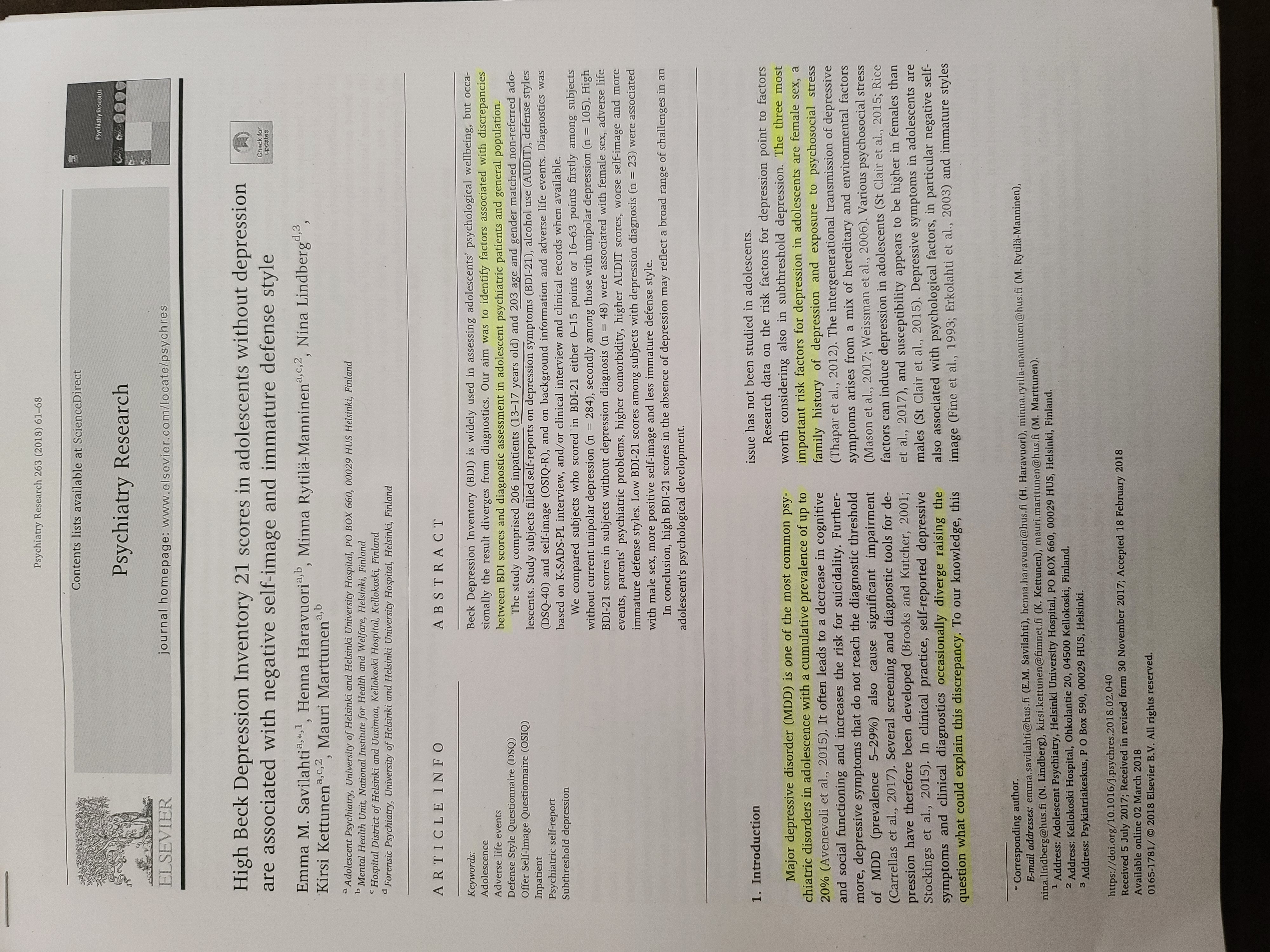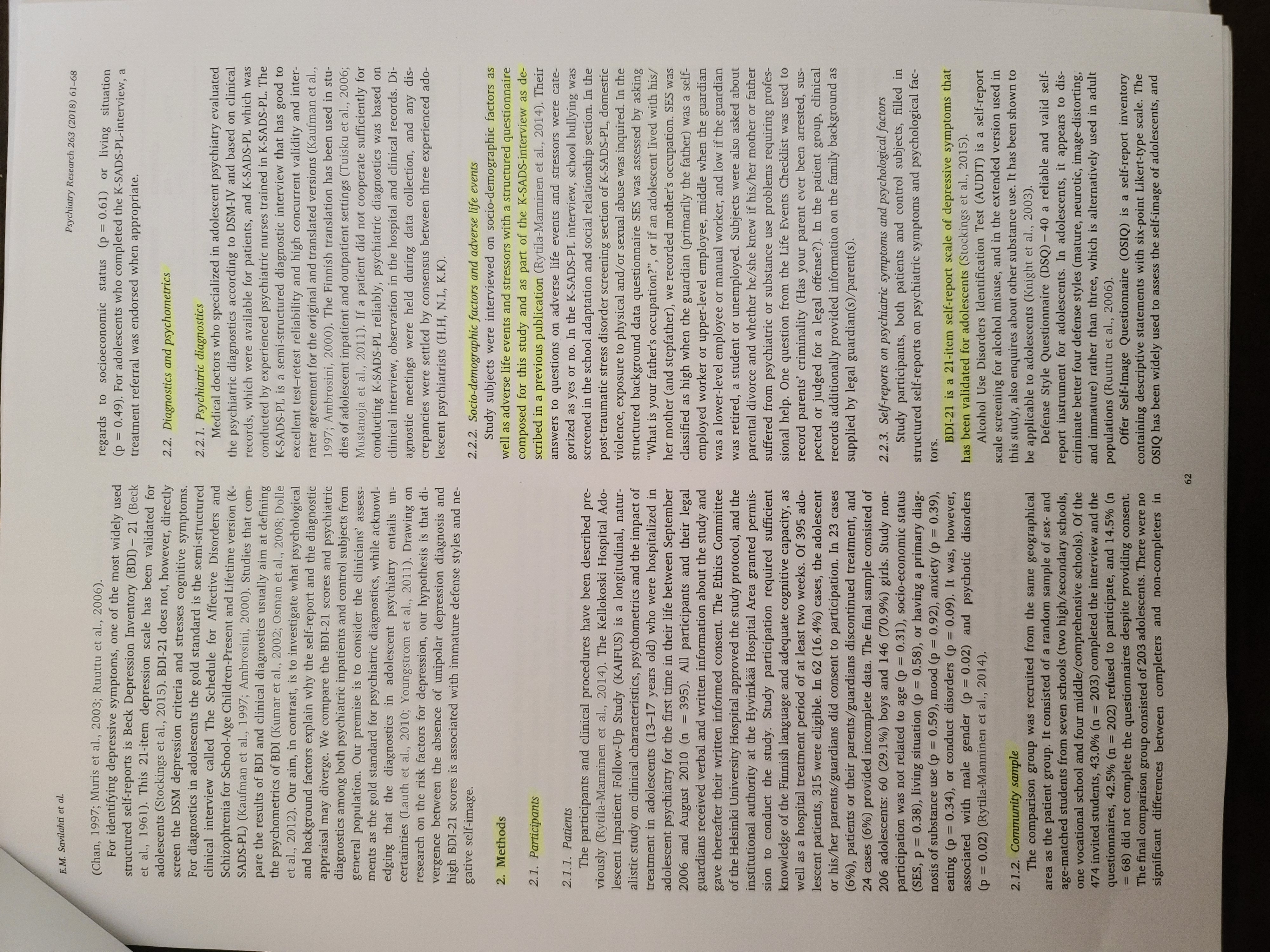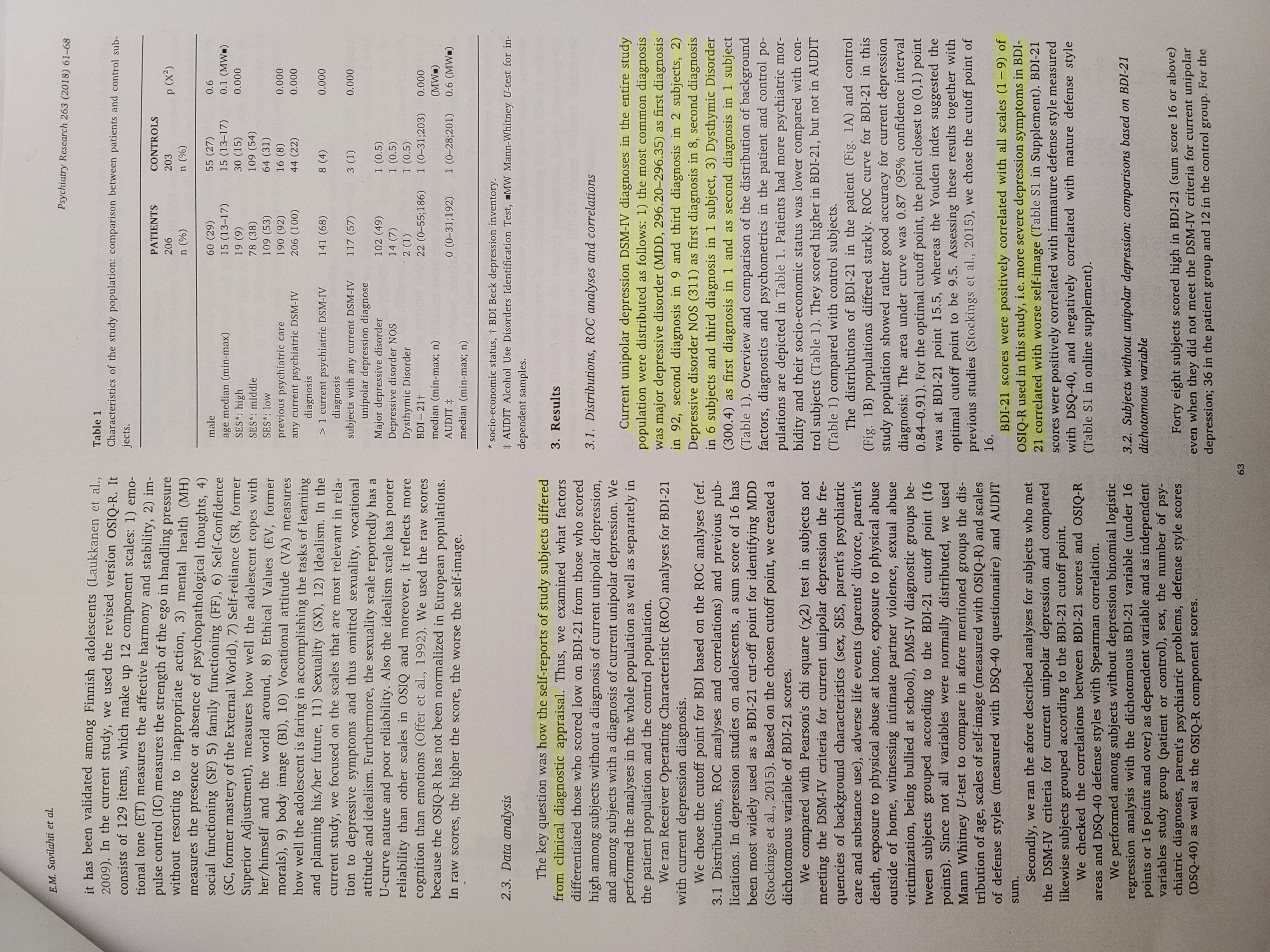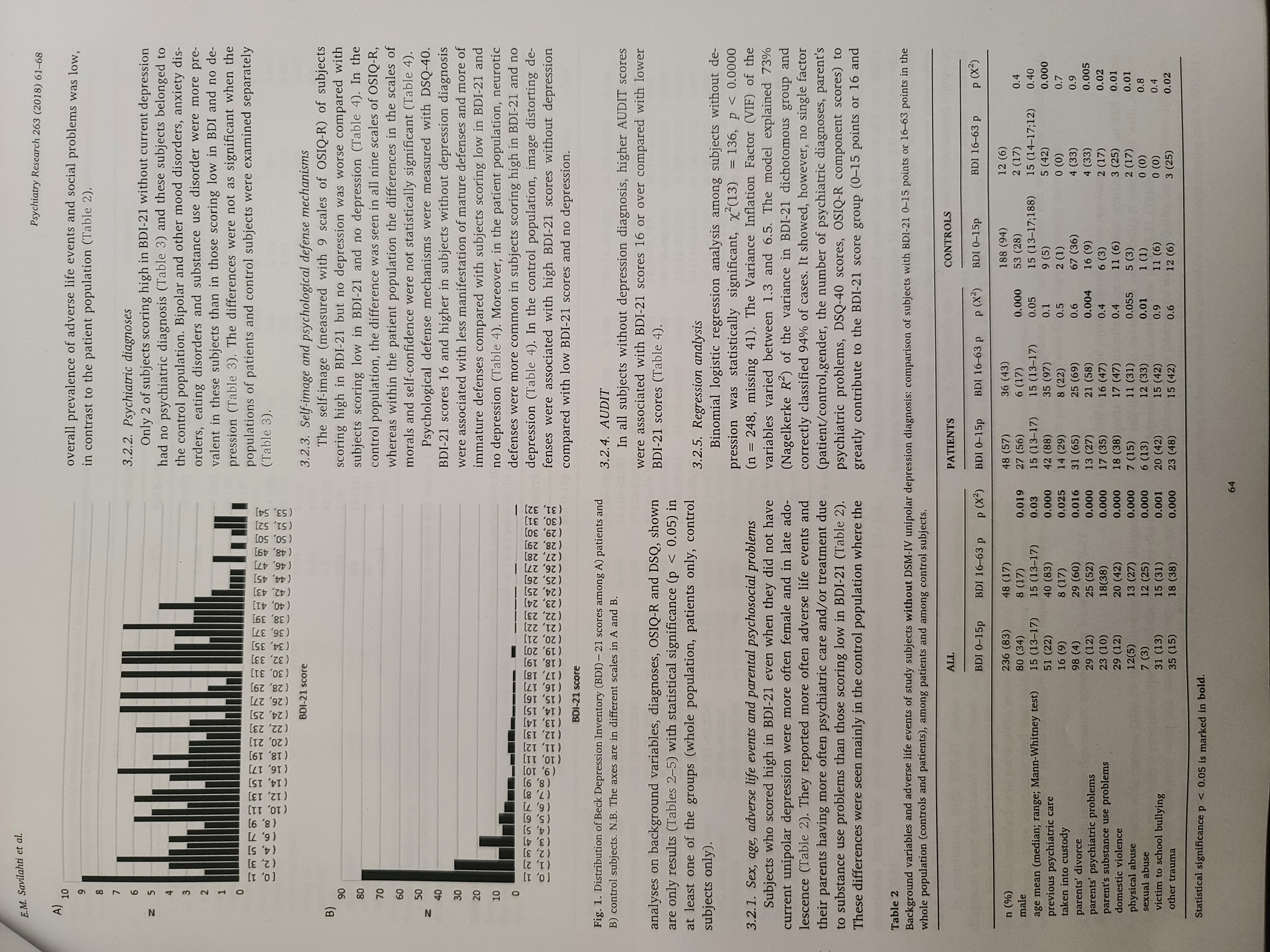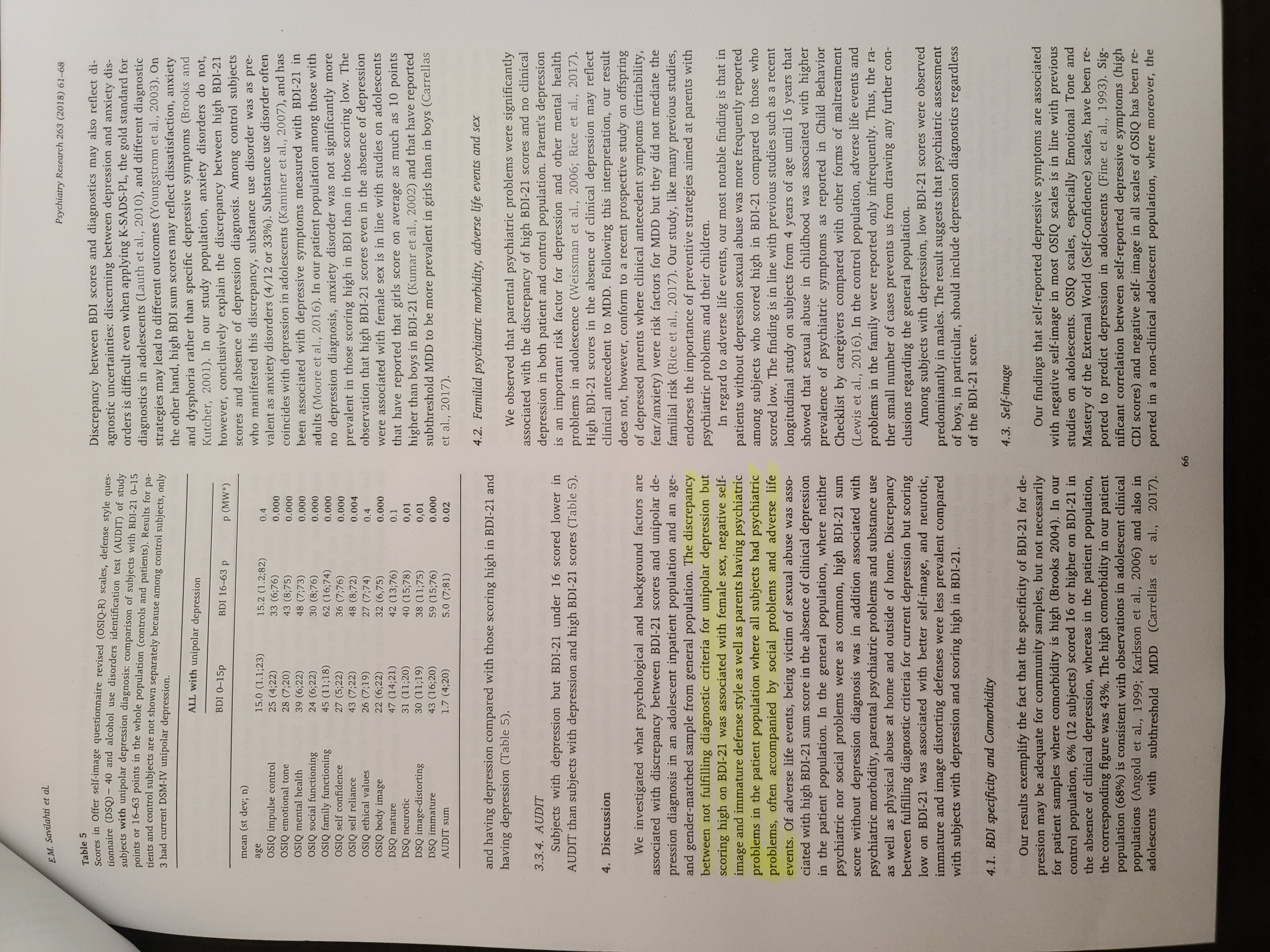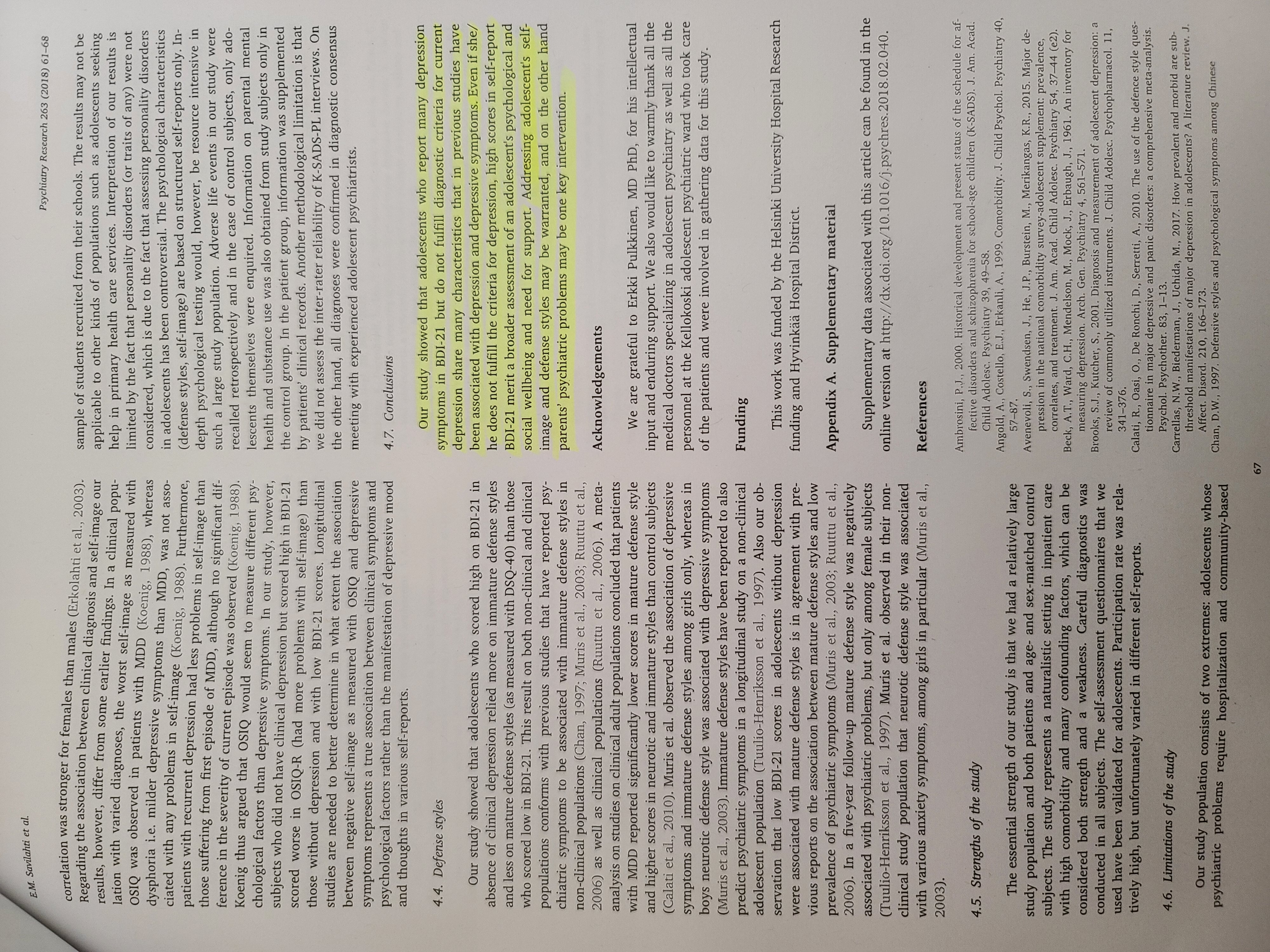Review the "high beck depression inventory 21 scores in adolescents without depression are associated with negative self image and immature defense style". Discuss the types of validity and reliability covered. Describe the forms of reliability and validity in depth and how they relate to the instrument. Provide interpretation of the quality of the sample ( size and diversity) and weather the instrument was appropriate for the population. How would you use this information in a career as a school counselor?
Psychiatry Research 263 (2018) 61-68 Contents lists available at ScienceDirect Psychiatry Research Psychiatry Research ELSEVIER journal homepage: www.elsevier.com/locate/psychres High Beck Depression Inventory 21 scores in adolescents without depression are associated with negative self-image and immature defense style Check for updates Emma M. Savilahtia*,, Henna Haravuoriab, Minna Rytila-Manninenac,2, Nina Lindbergd3, Kirsi Kettunen ,2, Mauri Marttunenab a Adolescent Psychiatry, University of Helsinki and Helsinki University Hospital, PO BOX 660, 00029 HUS Helsinki, Finland Mental Health Unit, National Institute for Health and Welfare, Helsinki, Finland Hospital District of Helsinki and Uusimad, Kellokoski Hospital, Kellokoski, Finland Forensic Psychiatry, University of Helsinki and Helsinki University Hospital, Helsinki, Finland ARTICLE INFO ABSTRACT Keywords: Adolescence Beck Depression Inventory (BDI) is widely used in assessing adolescents' psychological wellbeing, but occa- Adverse life events sionally the result diverges from diagnostics. Our aim was to identify factors associated with discrepancies Defense Style Questionnaire (DSQ) between BDI scores and diagnostic assessment in adolescent psychiatric patients and general population. Offer Self-Image Questionnaire (OSIQ) The study comprised 206 inpatients (13-17 years old) and 203 age and gender matched non-referred ado- Inpatient lescents. Study subjects filled self-reports on depression symptoms (BDI-21), alcohol use (AUDIT), defense styles Psychiatric self-report (DSQ-40) and self-image (OSIQ-R), and on background information and adverse life events. Diagnostics was Subthreshold depression based on K-SADS-PL interview, and/or clinical interview and clinical records when available. We compared subjects who scored in BDI-21 either 0-15 points or 16-63 points firstly among subjects without current unipolar depression (n = 284), secondly among those with unipolar depression (n = 105). High BDI-21 scores in subjects without depression diagnosis (n = 48) were associated with female sex, adverse life events, parents' psychiatric problems, higher comorbidity, higher AUDIT scores, worse self-image and more immature defense styles. Low BDI-21 scores among subjects with depression diagnosis (n = 23) were associated with male sex, more positive self-image and less immature defense style. In conclusion, high BDI-21 scores in the absence of depression may reflect a broad range of challenges in an adolescent's psychological development. 1. Introduction issue has not been studied in adolescents. Research data on the risk factors for depression point to factors Major depressive disorder (MDD) is one of the most common psy- worth considering also in subthreshold depression. The three most chiatric disorders in adolescence with a cumulative prevalence of up to important risk factors for depression in adolescents are female sex, a 20% (Avenevoli et al., 2015). It often leads to a decrease in cognitive family history of depression and exposure to psychosocial stress and social functioning and increases the risk for suicidality. Further- (Thapar et al., 2012). The intergenerational transmission of depressive more, depressive symptoms that do not reach the diagnostic threshold symptoms arises from a mix of hereditary and environmental factors of MDD (prevalence 5-29%) also cause significant impairment (Mason et al., 2017; Weissman et al., 2006). Various psychosocial stress (Carrellas et al., 2017). Several screening and diagnostic tools for de- factors can induce depression in adolescents (St Clair et al., 2015; Rice pression have therefore been developed (Brooks and Kutcher, 2001; et al., 2017), and susceptibility appears to be higher in females than Stockings et al., 2015). In clinical practice, self-reported depressive males (St Clair et al., 2015). Depressive symptoms in adolescents are symptoms and clinical diagnostics occasionally diverge raising the also associated with psychological factors, in particular negative self- question what could explain this discrepancy. To our knowledge, this image (Fine et al., 1993; Erkolahti et al., 2003) and immature styles Corresponding author. E-mail addresses: emma.savilahti@hus.fi (E.M. Savilahti), henna,haravuori@hus.fi (H. Haravuori), minna.rytila-manninen@hus.fi (M. Rytila-Manninen), nina.lindberg@hus.fi (N. Lindberg), kirsi. kettunen@fimnet.fi (K. Kettunen), mauri, marttunen@hus.fi (M. Marttunen). Address: Adolescent Psychiatry, Helsinki University Hospital, PO BOX 660, 00029 HUS, Helsinki, Finland. Address: Kellokoski Hospital, Ohkolantie 20, 04500 Kellokoski, Finland, Address: Psykiatriakeskus, P O Box 590, 00029 HUS, Helsinki. https://doi.org/10.1016/j.psychres.2018.02.040 Received 5 July 2017; Received in revised form 30 November 2017; Accepted 18 February 2018 Available online 02 March 2018 0165-1781/ @ 2018 Elsevier B.V. All rights reserved.E.M. Savilahti et al. Psychiatry Research 263 (2018) 61-68 (Chan, 1997; Muris et al., 2003; Ruuttu et al., 2006). For identifying depressive symptoms, one of the most widely used regards to socioeconomic status (p = 0.61) or living situation structured self-reports is Beck Depression Inventory (BDI) - 21 (Beck (p = 0.49). For adolescents who completed the K-SADS-PL-interview, a et al., 1961). This 21-item depression scale has been validated for treatment referral was endorsed when appropriate. adolescents (Stockings et al., 2015). BDI-21 does not, however, directly screen the DSM depression criteria and stresses cognitive symptoms. 2.2. Diagnostics and psychometrics For diagnostics in adolescents the gold standard is the semi-structured clinical interview called The Schedule for Affective Disorders and 2.2.1. Psychiatric diagnostics Schizophrenia for School-Age Children-Present and Lifetime version (K- Medical doctors who specialized in adolescent psychiatry evaluated SADS-PL) (Kaufman et al., 1997; Ambrosini, 2000). Studies that com- the psychiatric diagnostics according to DSM-IV and based on clinical pare the results of BDI and clinical diagnostics usually aim at defining records, which were available for patients, and K-SADS-PL which was the psychometrics of BDI (Kumar et al., 2002; Osman et al., 2008; Dolle conducted by experienced psychiatric nurses trained in K-SADS-PL. The et al., 2012). Our aim, in contrast, is to investigate what psychological K-SADS-PL is a semi-structured diagnostic interview that has good to and background factors explain why the self-report and the diagnostic excellent test-retest reliability and high concurrent validity and inter- appraisal may diverge. We compare the BDI-21 scores and psychiatric rater agreement for the original and translated versions (Kaufman et al., diagnostics among both psychiatric inpatients and control subjects from 1997; Ambrosini, 2000). The Finnish translation has been used in stu- general population. Our premise is to consider the clinicians' assess- dies of adolescent inpatient and outpatient settings (Tuisku et al., 2006; ments as the gold standard for psychiatric diagnostics, while acknowl Mustanoja et al., 2011). If a patient did not cooperate sufficiently for edging that the diagnostics in adolescent psychiatry entails un- conducting K-SADS-PL reliably, psychiatric diagnostics was based on certainties (Lauth et al., 2010; Youngstrom et al., 2011). Drawing on clinical interview, observation in the hospital and clinical records. Di- research on the risk factors for depression, our hypothesis is that di- agnostic meetings were held during data collection, and any dis- vergence between the absence of unipolar depression diagnosis and crepancies were settled by consensus between three experienced ado- high BDI-21 scores is associated with immature defense styles and ne- lescent psychiatrists (H.H, N.L, K.K). gative self-image. 2.2.2. Socio-demographic factors and adverse life events 2. Methods Study subjects were interviewed on socio-demographic factors as well as adverse life events and stressors with a structured questionnaire 2.1. Participants composed for this study and as part of the K-SADS-interview as de- scribed in a previous publication (Rytila-Manninen et al., 2014). Their 2.1.1. Patients answers to questions on adverse life events and stressors were cate- The participants and clinical procedures have been described pre- gorized as yes or no. In the K-SADS-PL interview, school bullying was viously (Rytila-Manninen et al., 2014). The Kellokoski Hospital Ado- screened in the school adaptation and social relationship section. In the lescent Inpatient Follow-Up Study (KAIFUS) is a longitudinal, natur- post-traumatic stress disorder screening section of K-SADS-PL, domestic alistic study on clinical characteristics, psychometrics and the impact of violence, exposure to physical and/or sexual abuse was inquired. In the structured background data questionnaire SES was assessed by asking treatment in adolescents (13-17 years old) who were hospitalized in "What is your father's occupation?", or if an adolescent lived with his/ adolescent psychiatry for the first time in their life between September 2006 and August 2010 (n = 395). All participants and their legal her mother (and stepfather), we recorded mother's occupation. SES was classified as high when the guardian (primarily the father) was a self- guardians received verbal and written information about the study and employed worker or upper-level employee, middle when the guardian gave thereafter their written informed consent. The Ethics Committee of the Helsinki University Hospital approved the study protocol, and the was a lower-level employee or manual worker, and low if the guardian was retired, a student or unemployed. Subjects were also asked about institutional authority at the Hyvinkaa Hospital Area granted permis- parental divorce and whether he/she knew if his/her mother or father sion to conduct the study. Study participation required sufficient suffered from psychiatric or substance use problems requiring profes- knowledge of the Finnish language and adequate cognitive capacity, as sional help. One question from the Life Events Checklist was used to well as a hospital treatment period of at least two weeks. Of 395 ado- record parents' criminality (Has your parent ever been arrested, sus- lescent patients, 315 were eligible. In 62 (16.4%) cases, the adolescent pected or judged for a legal offense?). In the patient group, clinical or his/her parents/guardians did consent to participation. In 23 cases records additionally provided information on the family background as (6%), patients or their parents/guardians discontinued treatment, and supplied by legal guardian(s)/parent(s). 24 cases (6%) provided incomplete data. The final sample consisted of 206 adolescents: 60 (29.1%) boys and 146 (70.9%) girls. Study non- 2.2.3. Self-reports on psychiatric symptoms and psychological factors participation was not related to age (p = 0.31), socio-economic status Study participants, both patients and control subjects, filled in (SES, p = 0.38), living situation (p = 0.58), or having a primary diag- structured self-reports on psychiatric symptoms and psychological fac- nosis of substance use (p = 0.59), mood (p = 0.92), anxiety (p = 0.39), tors . eating (p = 0.34), or conduct disorders (p = 0.09). It was, however, BDI-21 is a 21-item self-report scale of depressive symptoms that associated with male gender (p = 0.02) and psychotic disorders has been validated for adolescents (Stockings et al., 2015). (p = 0.02) (Rytila-Manninen et al., 2014). Alcohol Use Disorders Identification Test (AUDIT) is a self-report scale screening for alcohol misuse, and in the extended version used in 2.1.2. Community sample this study, also enquires about other substance use. It has been shown to The comparison group was recruited from the same geographical be applicable to adolescents (Knight et al., 2003). area as the patient group. It consisted of a random sample of sex- and Defense Style Questionnaire (DSQ) -40 a reliable and valid self- age-matched students from seven schools (two high/secondary schools, report instrument for adolescents. In adolescents, it appears to dis- one vocational school and four middle/comprehensive schools). Of the criminate better four defense styles (mature, neurotic, image-distorting, 474 invited students, 43.0% (n = 203) completed the interview and the and immature) rather than three, which is alternatively used in adult questionnaires, 42.5% (n = 202) refused to participate, and 14.5% (n populations (Ruuttu et al., 2006). = 68) did not complete the questionnaires despite providing consent. Offer Self-Image Questionnaire (OSIQ) is a self-report inventory The final comparison group consisted of 203 adolescents. There were no containing descriptive statements with six-point Likert-type scale. The significant differences between completers and non-completers in OSIQ has been widely used to assess the self-image of adolescents, and 62E.M. Savilahti et al. Psychiatry Research 263 (2018) 61-68 it has been validated among Finnish adolescents (Laukkanen et al., 2009). In the current study, we used the revised version OSIQ-R. It Table 1 consists of 129 items, which make up 12 component scales: 1) emo- Characteristics of the study population: comparison between patients and control sub- jects. tional tone (ET) measures the affective harmony and stability, 2) im- pulse control (IC) measures the strength of the ego in handling pressure PATIENTS CONTROLS without resorting to inappropriate action, 3) mental health (MH) 206 203 P (X2) measures the presence or absence of psychopathological thoughts, 4) n (%) n (%) social functioning (SF) 5) family functioning (FF), 6) Self-Confidence male 60 (29) 55 (27) 0.6 (SC, former mastery of the External World), 7) Self-reliance (SR, former age median (min-max) 15 (13-17) 15 (13-17) 0.1 (MW=) Superior Adjustment), measures how well the adolescent copes with SES*: high 19 (9) 30 (15) 0.000 her/himself and the world around, 8) Ethical Values (EV, former SES*: middle 78 (38) 09 (54) SES*: low 109 (53) 64 (31) morals), 9) body image (BI), 10) Vocational attitude (VA) measures previous psychiatric care 190 (92) 16 (8 0.000 how well the adolescent is faring in accomplishing the tasks of learning any current psychiatric DSM-IV 206 (100) 44 (22) 0.000 and planning his/her future, 11) Sexuality (SX), 12) Idealism. In the diagnosis > 1 current psychiatric DSM-IV 141 (68) 8 (4) 0.000 current study, we focused on the scales that are most relevant in rela- diagnosis tion to depressive symptoms and thus omitted sexuality, vocational subjects with any current DSM-IV 117 (57) 3 1 0.000 attitude and idealism. Furthermore, the sexuality scale reportedly has a unipolar depression diagnose J-curve nature and poor reliability. Also the idealism scale has poorer Major depressive disorder 102 (49) 1 (0.5) reliability than other scales in OSIQ and moreover, it reflects more Depressive disorder NOS 14 (7 ) (0.5) Dysthymic Disorder 2 ( 1 ) 1 (0.5) cognition than emotions (Offer et al., 1992). We used the raw scores BDI - 21+ 22 (0-55;186) 1 (0-31;203) 0.000 because the OSIQ-R has not been normalized in European populations. median (min-max; n) (MW=) In raw scores, the higher the score, the worse the self-image. AUDIT $ 0 (0-31;192) 1 (0-28;201) 0.6 (MW=) median (min-max; n) 2.3. Data analysis * socio-economic status, i BDI Beck depression inventory. + AUDIT Alcohol Use Disorders Identification Test, .MW Mann-Whitney U-test for in- dependent samples. The key question was how the self-reports of study subjects differed from clinical diagnostic appraisal. Thus, we examined what factors 3. Results differentiated those who scored low on BDI-21 from those who scored high among subjects without a diagnosis of current unipolar depression, 3.1. Distributions, ROC analyses and correlations and among subjects with a diagnosis of current unipolar depression. We performed the analyses in the whole population as well as separately in Current unipolar depression DSM-IV diagnoses in the entire study the patient population and the control population. population were distributed as follows: 1) the most common diagnosis We ran Receiver Operating Characteristic (ROC) analyses for BDI-21 was major depressive disorder (MDD, 296.20-296.35) as first diagnosis with current depression diagnosis. in 92, second diagnosis in 9 and third diagnosis in 2 subjects, 2) We chose the cutoff point for BDI based on the ROC analyses (ref. Depressive disorder NOS (311) as first diagnosis in 8, second diagnosis 3.1 Distributions, ROC analyses and correlations) and previous pub- in 6 subjects and third diagnosis in 1 subject, 3) Dysthymic Disorder lications. In depression studies on adolescents, a sum score of 16 has (300.4) as first diagnosis in 1 and as second diagnosis in 1 subject been most widely used as a BDI-21 cut-off point for identifying MDD (Table 1). Overview and comparison of the distribution of background Stockings et al., 2015). Based on the chosen cutoff point, we created a factors, diagnostics and psychometrics in the patient and control po- dichotomous variable of BDI-21 scores. pulations are depicted in Table 1. Patients had more psychiatric mor- We compared with Pearson's chi square (x2) test in subjects not bidity and their socio-economic status was lower compared with con- meeting the DSM-IV criteria for current unipolar depression the fre- trol subjects (Table 1). They scored higher in BDI-21, but not in AUDIT quencies of background characteristics (sex, SES, parent's psychiatric (Table 1) compared with control subjects. care and substance use), adverse life events (parents' divorce, parent's The distributions of BDI-21 in the patient (Fig. 1A) and control death, exposure to physical abuse at home, exposure to physical abuse (Fig. 1B) populations differed starkly. ROC curve for BDI-21 in this outside of home, witnessing intimate partner violence, sexual abuse study population showed rather good accuracy for current depression victimization, being bullied at school), DMS-IV diagnostic groups be- diagnosis: The area under curve was 0.87 (95% confidence interval tween subjects grouped according to the BDI-21 cutoff point (16 0.84-0.91). For the optimal cutoff point, the point closest to (0,1) point points). Since not all variables were normally distributed, we used was at BDI-21 point 15.5, whereas the Youden index suggested the Mann Whitney U-test to compare in afore mentioned groups the dis- optimal cutoff point to be 9.5. Assessing these results together with tribution of age, scales of self-image (measured with OSIQ-R) and scales previous studies (Stockings et al., 2015), we chose the cutoff point of of defense styles (measured with DSQ-40 questionnaire) and AUDIT 16. sum. BDI-21 scores were positively correlated with all scales (1-9) of Secondly, we ran the afore described analyses for subjects who met OSIQ-R used in this study, i.e. more severe depression symptoms in BDI- the DSM-IV criteria for current unipolar depression and compared 21 correlated with worse self-image (Table S1 in Supplement). BDI-21 likewise subjects grouped according to the BDI-21 cutoff point. scores were positively correlated with immature defense style measured We checked the correlations between BDI-21 scores and OSIQ-R with DSQ-40, and negatively correlated with mature defense style areas and DSQ-40 defense styles with Spearman correlation. (Table S1 in online supplement). We performed among subjects without depression binomial logistic regression analysis with the dichotomous BDI-21 variable (under 16 3.2. Subjects without unipolar depression: comparisons based on BDI-21 points or 16 points and over) as dependent variable and as independent dichotomous variable variables study group (patient or control), sex, the number of psy- chiatric diagnoses, parent's psychiatric problems, defense style scores Forty eight subjects scored high in BDI-21 (sum score 16 or above) (DSQ-40) as well as the OSIQ-R component scores. even when they did not meet the DSM-IV criteria for current unipolar depression; 36 in the patient group and 12 in the control group. For theE.M. Savilahti et al. Psychiatry Research 263 (2018) 61-68 A) 10 overall prevalence of adverse life events and social problems was low, in contrast to the patient population (Table 2). 3.2.2. Psychiatric diagnoses Only 2 of subjects scoring high in BDI-21 without current depression had no psychiatric diagnosis (Table 3) and these subjects belonged to the control population. Bipolar and other mood disorders, anxiety dis- orders, eating disorders and substance use disorder were more pre- valent in these subjects than in those scoring low in BDI and no de- O pression (Table 3). The differences were not as significant when the [0, 2) 2, 3] (4, 5] (6, 7] (8, 9] (10, 11] (12, 13] (14, 15] (16, 17] (18, 19] (20, 21] 2, 23] (26 , 2 (28, 29] (30, 31] populations of patients and control subjects were examined separately (32 , 3 (34 , 35 ] "Table 3). 8DI-21 score 3.2.3. Self-image and psychological defense mechanisms B) 5 8 8 688 8 8 8 The self-image (measured with 9 scales of OSIQ-R) of subjects scoring high in BDI-21 but no depression was worse compared with subjects scoring low in BDI-21 and no depression (Table 4). In the control population, the difference was seen in all nine scales of OSIQ-R, whereas within the patient population the differences in the scales of morals and self-confidence were not statistically significant (Table 4). Z Psychological defense mechanisms were measured with DSQ-40. BDI-21 scores 16 and higher in subjects without depression diagnosis were associated with less manifestation of mature defenses and more of immature defenses compared with subjects scoring low in BDI-21 and no depression (Table 4). Moreover, in the patient population, neurotic 8, 19 ] ( 21, 22] defenses were more common in subjects scoring high in BDI-21 and no 19, 2 (20, 2 ( 22 , 2 (23 , 24 ] (29, 3 ( 31, 32] | depression (Table 4). In the control population, image distorting de- fenses were associated with high BDI-21 scores without depression 801-21 score compared with low BDI-21 scores and no depression. Fig. 1. Distribution of Beck Depression Inventory (BDI) -21 scores among A) patients and B) control subjects. N.B. The axes are in different scales in A and B. 3.2.4. AUDIT In all subjects without depression diagnosis, higher AUDIT scores analyses on background variables, diagnoses, OSIQ-R and DSQ, shown were associated with BDI-21 scores 16 or over compared with lower are only results (Tables 2-5) with statistical significance (p
